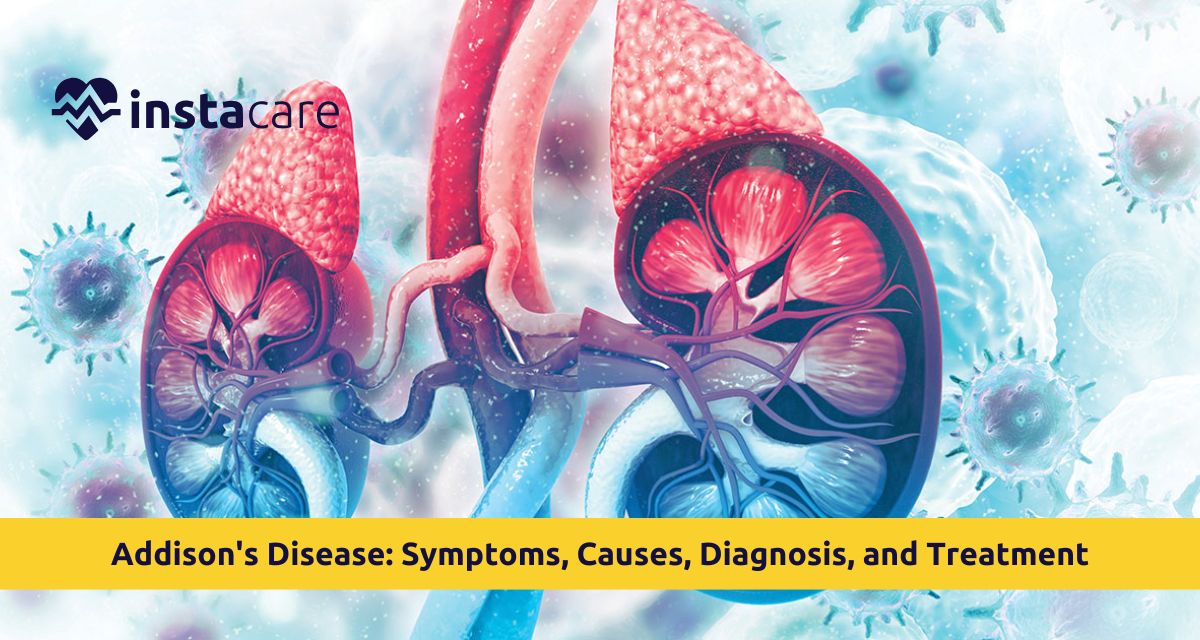Addison’s disease remains a vital yet dangerous endocrine disorder since it damages the adrenal glands' capacity to perform their functions. The top-facing adrenal glands present in each kidney serve as essential hormone producers for metabolism regulation and immune system maintenance and stress responses and blood pressure control functions.
In Addison’s disease, the glands become damaged so the body produces too few hormones, including cortisol and aldosterone. The combination of early diagnosis and right medical intervention enables patients to maintain their regular healthy routines even though their illness remains a threat for untreated conditions.
The blog delivers Addison's disease content beginning with its definition and patient effects, followed by symptom explanations alongside origin information and diagnostic and treatment methods
What is Addison's Disease?
Addison’s disease acts as a chronic condition that blocks normal cortisol production in the adrenal glands while potentially also affecting aldosterone production also. Both cortisol hormones and pressure maintenance serve as essential elements for the body's stress mechanism which supports cardiovascular function and metabolic regulation. The blood pressure regulation function stems from aldosterone's ability to manage sodium and potassium amounts.
Lack of hormone production results in body system misalignment that causes fatigue and blood pressure decrease and could potentially trigger deadly adrenal crisis conditions.
Most Addison’s disease instances stem from autoimmune processes that assault the adrenal body tissue. The disease shows no gender preference yet most patients start showing symptoms between 30 and 50 years old although it can affect individuals at any age.
Various Symptoms of Addison’s Disease
The gradual development of symptoms in Addison’s disease causes patients to exhibit symptoms that healthcare providers often confuse with typical conditions like
depression and chronic fatigue syndrome, or gastrointestinal problems. A correct diagnosis becomes difficult when no medical evaluation is involved. Some common symptoms include:
- Chronic fatigue and muscle weakness
- Loss of appetite and unintended weight loss
- The condition leads to low blood pressure, which becomes noticeable primarily when standing.
- Craving for salty foods
- Hyperpigmentation causes skin darkening, especially at body scars and creases, as well as within mucous membranes.
- Low blood sugar (hypoglycemia)
- Nausea, vomiting, or diarrhoea
- Mood swings, irritability, or depression
- Abdominal or joint pain
- Irregular or absent menstrual periods in women
Some Causes of Addison’s Disease
Addison’s disease usually develops due to autoimmune damage to the adrenal cortex, although alternative factors can attenuate its progress.
1. Autoimmune Adrenalitis
The immune system of the body accidentally attacks the adrenal glands, thus damaging the cortex, which leads to hormone impairment. This represents the primary cause. Patients typically experience this condition together with various autoimmune disorders, including:
- Type 1 diabetes
- Hashimoto’s thyroiditis
- Vitiligo
- Pernicious anemia
2. Infections
Several infection types result in damage to the adrenal glands through:
- TB contributes to becoming one of the primary disease occurrences in nations with developing economies.
- Fungal infections
- HIV/AIDS
- Cytomegalovirus (CMV)
3. Genetic Conditions
Addison’s disease has inherited origins through two specific conditions, namely congenital adrenal hyperplasia (CAH) and autoimmune polyendocrine syndrome (APS).
4. Cancer or Metastatic Disease
The spread of lung or breast cancer to the adrenal glands reduces their ability to function properly.
5. Adrenal Haemorrhage or Trauma
The onset of acute adrenal insufficiency takes place when bleeding occurs inside the adrenal glands from injuries or anticoagulant drugs.
The Diagnosis of Addison’s Disease
Proper diagnosis of Addison’s disease requires a combination of clinical examinations and both blood tests and imaging evaluations. A correct diagnosis of adrenal insufficiency requires distinct diagnostic tests because its symptoms match those of several other possible conditions.
1. Medical History and Physical Examination
A doctor will examine symptoms along with medical background and physical signs that include hyperpigmentation and low blood pressure with weight loss.
2. Blood Tests
- Blood cortisol levels serve as a crucial diagnostic marker since they remain at low levels.
- Primary adrenal insufficiency is identified by elevated levels of ACTH stimulation test with low cortisol readings.
- Addison's disease commonly causes two opposite electrolyte problems: sodium levels drop while potassium levels rise.
- The assessment of aldosterone function depends on laboratory measurements of renin levels along with aldosterone values.
- Low blood glucose can develop because of cortisol production defects.
3. ACTH Stimulation Test (Synacthen Test)
Medical professionals consider this test to be the primary diagnostic method for identifying Addison’s disease. The procedure determines how adrenal glands react to synthetic ACTH injections. Laboratory tests that measure adrenal gland cortisol response determine adrenal insufficiency.
4. Imaging Studies
- CT or MRI scans detect possible changes in adrenal gland structure by showing size alterations and calcifications as well as tissue damage.
- Medical examinations usually do not show alterations in adrenal gland dimensions in patients with autoimmune conditions.
5. Autoimmune Antibody Tests
- Blood tests looking for 21-hydroxylase antibodies will establish an autoimmune origin.
- Patients need prompt diagnosis for successful treatment of symptoms to avoid adrenal crisis.
What Includes Addison’s Disease Treatment?
The lifelong treatment for Addison's disease requires hormone replacement therapy that replicates adrenals' regular functions. The main goal of treatment is to achieve hormonal equilibrium while stopping adrenal crises and enabling normal life activities for patients.
1. Cortisol Replacement
- Patients receive hydrocortisone or prednisolone or dexamethasone medications to replace cortisol in their bodies.
- A patient’s medicated cortisol intake might need review when they experience stress or become sick or need surgical procedures to match cortisol levels the body generates naturally.
2. Aldosterone Replacement
- Fludrocortisone acetate functions as an aldosterone replacement therapy to manage blood pressure levels and control electrolytes in the body.
- People should control their sodium consumption, specifically in hot weather conditions and when they perform intensive exercise activities.
3. Emergency Treatment for Adrenal Crisis
If an adrenal crisis occurs, immediate treatment includes:
- Intravenous hydrocortisone
- IV fluids with glucose and electrolytes
- Close monitoring in a hospital setting
4. Lifestyle Management
- Consumers should follow a balanced eating plan that includes adequate salt intake.
- Hydration becomes essential in conditions of illness and heat to maintain good health, especially during these times.
- You should learn to change your medications when your physical or emotional state becomes unstable.
- Healthcare providers must conduct routine follow-up assessments that assess hormone levels in addition to medication effectiveness.
Conclusion
Knowledge of Addison’s disease symptoms and causes, alongside proper treatment possibilities, remains vital for discovering the condition early to achieve successful clinical management. Through medical care involving hormone replacement along with self-awareness, individuals with Addison’s disease can enjoy ful,l active lives. Treatment success depends greatly on recognising an adrenal crisis immediately and following prescribed medication regimens to avoid medical problems and preserve lasting health.
Please book an appointment with the
best Endocrinologist in Lahore, Karachi, Islamabad, and all major cities of Pakistan through
InstaCare, or call our helpline at 03171777509 to find the verified doctor for your disease.

